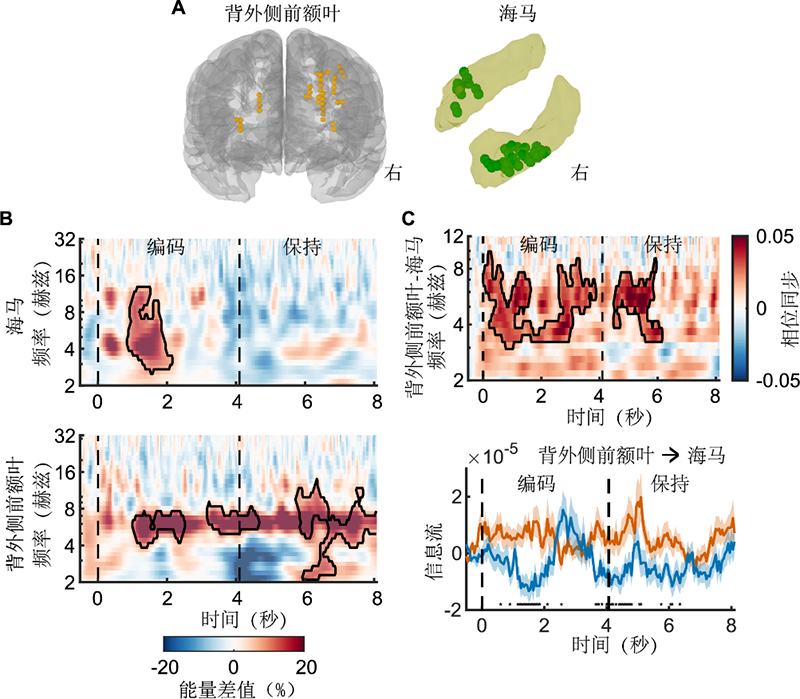Time:2023-10-18
A recent study published in Neuroscience Bulletin demonstrated that theta oscillations support prefrontal-hippocampal interactions in sequential working memory. This work was performed by researchers in Dr. YE Zheng’s Lab at the Institute of Neuroscience, Center for Excellence in Brain Sciences and Intelligence Technology of the Chinese Academy of Sciences, and Prof. ZHAN Shikun at the Ruijin Hospital, Shanghai Jiao Tong University School of Medicine.
The ability to process sequential information online is essential for a broad spectrum of daily activities, from making a conversation (what to say first) to preparing a meal (what to do first). Patients with neurodegenerative diseases such as Parkinson’s disease and Alzheimer’s disease often have difficulty understanding stories that are told backward and planning sequential steps to solve a problem. In their previous work, the researchers found that theta oscillations reflect the online processing of sequential information in the human brain.
To better understand the neural mechanisms of sequential working memory, the researchers used stereoelectroencephalography with magnetic resonance imaging, and recorded local field potentials from 43 dorsolateral prefrontal sites and 56 hippocampal sites in twenty epilepsy patients who completed a line ordering task.
The researchers found that in the human brain, the dorsolateral prefrontal cortex interacted with the hippocampus through theta oscillations in the online processing of sequential information. First, the hippocampus showed a transient theta power increase for encoding sequential information, and the dorsolateral prefrontal cortex showed a sustained theta power increase for encoding and maintaining sequential information. Second, theta phase coherences between the dorsolateral prefrontal cortex and hippocampus were enhanced for encoding and maintaining sequential information. Third, the theta band influence from the dorsolateral prefrontal cortex to the hippocampus was more significant than that from the hippocampus to the dorsolateral prefrontal cortex. Stronger theta phase coherences between the dorsolateral prefrontal cortex and hippocampus and more significant theta band influence from the dorsolateral prefrontal cortex to the hippocampus predicted more precise memory.
This work entitled “Theta oscillations support prefrontal-hippocampal interactions in sequential working memory” was published online in Neuroscience Bulletin on October 17,2023. Mr. SU Minghong at the University of Chinese Academy of Sciences and Dr. HU Kejia at the Ruijin Hospital are co-first authors. Dr. YE Zheng at the Institute of Neuroscience, Center for Excellence in Brain Sciences and Intelligence Technology of the Chinese Academy of Sciences, and Prof. ZHAN Shikun at the Ruijin Hospital are co-corresponding authors.
This work was supported by the Ministry of Science and Technology of China and the Shanghai Municipal Science and Technology Commission.

Figure legend: (A) Dorsolateral prefrontal (DLPFC) sites and hippocampal sites. (B) Increased theta powers in the hippocampus and DLPFC. (C) Enhanced theta phase coherences between the DLPFC and hippocampus (HP). Enhanced theta band influence from the DLPFC to the hippocampus.
Original article: https://link.springer.com/article/10.1007/s12264-023-01134-6
Keywords: theta oscillations, dorsolateral prefrontal cortex, hippocampus, stereoelectroencephalography, sequential working memory
AUTHOR CONTACT:
YE Zheng
Institute of Neuroscience, Center for Excellence in Brain Sciences and Intelligence Technology, Chinese Academy of Sciences, Shanghai, China.
Phone: 86.21.5492.1929; E-mail: yez@ion.ac.cn
 附件下载:
附件下载: